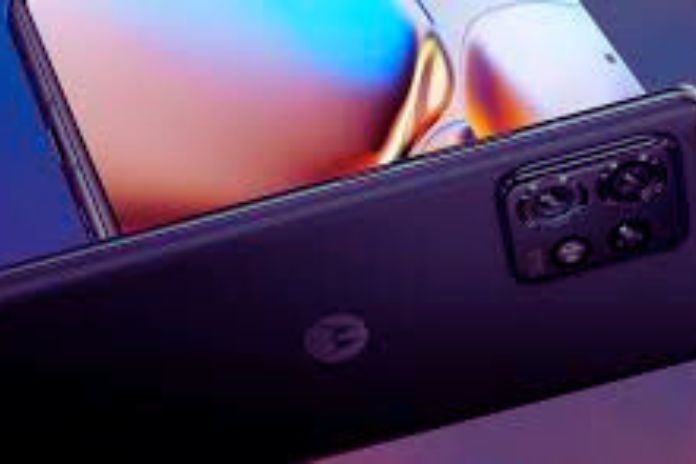Motorola Edge 40: Since the Edge line is the home of premium equipment from Motorola, its new models are expected to bring something new and make the brand a relevant presence in the top-of-the-line cell phone market.
And being the youngest of the family, the Motorola Edge 40 doesn’t live up to that expectation. Is this an enhanced version of the Edge 30 Fusion or just a limited version of the Edge 40 Pro? Check out our review to understand if the Motorola Edge 40 is worth it.
Design And Connectivity
The Motorola Edge 40 resembles the Edge 30 Fusion in many ways, and the design is one of them, having curved edges and slightly rounded edges. And like its predecessor, it also has a textured rear, with the dual-sensor camera module at the top left. This module means that the cell phone is not straight when placed under the table since the camera sensors are larger than the back of the smartphone, requiring a cover to match them in size. This is a visually beautiful and refined cell phone, which can be purchased in black, light green, and vivid magenta – the Pantone color 2023.
The layout of buttons on its body is also standard, with the lock button with the digital reader and volume controls on the right side. Its left side is completely button-free, as is the top, which only has one of the speakers and a microphone sensor. At the bottom are the SIM card drawer, the USB-C port, the second microphone sensor, and the second speaker. The Motorola Edge 40 has the Android13 oper
ating system, with 5G connectivity, Wifi 6, Bluetooth 5.2, NFC, and IP68 water and dust resistance certification.
Screen And Audio
The Edge 40 screen has p-OLED technology, 6.55 inches, Full HD + resolution, and has up to 144Hz refresh rate. It is to be expected a screen with great clarity, and that works very fluidly, despite falling behind the 165Hz present in the Pro version. And if you want to maintain a balance between fluidity and battery savings, keeping the refresh rate in the automatic option allows the cell phone to reach up to 120Hz natively.
Its maximum brightness is even better than the Edge 30 Fusion, allowing it to be used without major problems in sunlight. The display, in general, is one of the device’s strengths, displaying vivid colors, good resolution, and a good level of contrast. Edge 40 has HDR10 support but lacks Dolby Vision in the Pro version.
As for its audio, this model has stereo audio with Dolby Atmos support. And despite presenting a well-balanced sound, it needs to improve in the accentuation, being inferior to the Edge 30 Fusion and the Edge 40 Pro in the definition of more bass sounds.
Performance And Battery
The chipset responsible for processing the cell phone is MediaTek’s Dimensity 8020, which, added to its 8 GB of RAM, has enough firepower to run most mobile games and multitask cleanly and without hiccups. It’s not a big improvement over the Edge 30 Fusion, but it’s still a great performance phone, getting close to the ROG Phone 5s and the Xiaomi 12T Pro.
On the other hand, its battery can be considered one of the device’s weaknesses. Even amid an established standard of 5,000 mAh, the Motorola Edge 40 remains the same as the Edge 30 Fusion with 4,400 mAh of battery, even in premium cell phones. In return, it comes with a powerful 68W charger in its box. Therefore, the battery leaves something to be desired on the one hand, but it does not completely disappoint.
Cameras
The main camera has 50 MP, and its results in photos are mixed, being somewhere in the middle between being able to reproduce details but with some imperfections and artificial-looking textures, largely due to its post-processing. On the other hand, its ability to reproduce colors is good, as are its results in portrait mode.
In places with low light, the night mode is activated automatically and also has good results in general, both in terms of detail and color, which is a good evolution compared to the Edge 30 Fusion. This lens supports videos up to 4K at 30 frames per second in good quality but repeats some of the problems of textures with an artificial appearance.
Its second sensor is a 13 MP ultrawide, which works as a macro lens. Its results are intermediate and good during wide-angle, with good details but little brightness. As a macro lens, its results are excellent, standing out mainly for its vividness of colors.
This is a great success from Motorola in this model, considering several smartphones today have a dedicated macro lens, but usually with very little resolution and consequently low quality. This second lens can also record 4K videos at 30 fps, with a slightly lower quality than the main camera, but still good.
The front camera has 32 MP and also delivers good results, with great detail and without exaggerating the post-processing of textures, making selfies not look like an Instagram filter or a constant beautification mode. On the other hand, it lacks the autofocus present in the Edge 30 Fusion’s front camera. Its set of cameras is generally good, but it is in a mix between evolution and downgrade compared to the previous model.
Also Read: Is The Galaxy M54 Good? A Huge Battery Is The Only Contrast

